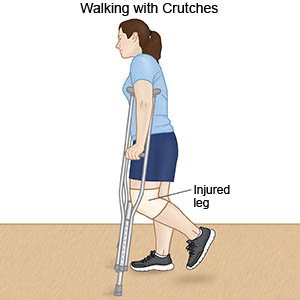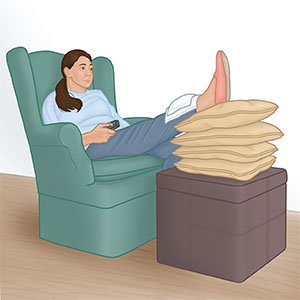Foot Sprain
Medically reviewed by Drugs.com. Last updated on Aug 4, 2025.
A foot sprain happens when a ligament stretches or tears. Ligaments connect bones, support joints, and keep bones in place.
DISCHARGE INSTRUCTIONS:
Return to the emergency department if:
- You have numbness or tingling below the injury, such as in your toes.
- The skin on your injured foot is blue or pale.
- You have increased pain, even after you take pain medicine.
Call your doctor if:
- You have new weakness in your foot.
- You have new or increased swelling in your foot.
- You have new or increased stiffness when you move your injured foot.
- You have questions or concerns about your condition or care.
Medicines:
- NSAIDs , such as ibuprofen, help decrease swelling, pain, and fever. This medicine is available with or without a doctor's order. NSAIDs can cause stomach bleeding or kidney problems in certain people. If you take blood thinner medicine, always ask if NSAIDs are safe for you. Always read the medicine label and follow directions. Do not give these medicines to children younger than 6 months without direction from a healthcare provider.
- Take your medicine as directed. Contact your healthcare provider if you think your medicine is not helping or if you have side effects. Tell your provider if you are allergic to any medicine. Keep a list of the medicines, vitamins, and herbs you take. Include the amounts, and when and why you take them. Bring the list or the pill bottles to follow-up visits. Carry your medicine list with you in case of an emergency.
Self-care:
- Rest your foot. Limit movement in your sprained foot for the first 2 to 3 days. You may need crutches to take weight off your injured foot as it heals. Use crutches as directed.

- Apply ice on your foot to decrease swelling and pain. Use an ice pack, or put crushed ice in a plastic bag. Cover the bag with a towel before you apply it to your foot. Apply ice for 15 to 20 minutes every hour or as directed.
- Compress your foot. You may need to use tape or an elastic bandage to support your foot if you have a mild sprain. You may need a splint on your foot for support if your sprain is severe. Wear your splint for as many days as directed.
- Elevate your foot above the level of your heart as often as you can. This will help decrease swelling and pain. Prop your foot on pillows or blankets to keep it elevated comfortably.

- Go to physical therapy, if directed. A physical therapist can teach you exercises to help restore strength and increase the range of motion in your foot. Ask your provider when you can return to your normal activities or play sports.
Prevent another foot sprain:
- Warm up and stretch before you exercise or play sports. This helps your joints and ligaments become strong and flexible.

- Use the right equipment. Always wear shoes that fit well and are made for the activity that you are doing. You may also need ankle supports, elbow and knee pads, or braces.
Follow up with your doctor as directed:
Write down your questions so you remember to ask them during your visits.
© Copyright Merative 2025 Information is for End User's use only and may not be sold, redistributed or otherwise used for commercial purposes.
The above information is an educational aid only. It is not intended as medical advice for individual conditions or treatments. Talk to your doctor, nurse or pharmacist before following any medical regimen to see if it is safe and effective for you.
Learn more about Foot Sprain
Care guides
Further information
Always consult your healthcare provider to ensure the information displayed on this page applies to your personal circumstances.
